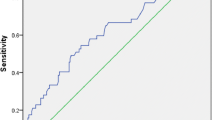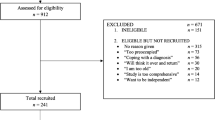Abstract
Objectives: A prospective, observational study was undertaken to identify risk profiles of subjects regarding the recurrence of falling among community-dwelling seniors using home-care services.
Methods: A convenience sample of 868 community-dwelling older persons, aged 65 years or older, who use home-care services offered by public community-based centres in the province of Québec. Subjects were recruited between 2002 and 2005, assessed for fall-related risk factors, and monitored for prospective falls. Data were examined by a classification and regression tree (CART) and survival analyses.
Results: Ninety-nine participants reported two falls within six months of entry to the study. Thus, the incidence of recurrent fallers was 11.4%. The tree analysis classified the population into five groups differing in risk of recurrent falling, based on history of falls in the three months prior to the initial interview, Berg balance score, type of housing, and usual alcohol consumption in the six months preceding study entry. The relative risks varied from 0.7 to 5.1. The survival analysis showed that the length of time before becoming a recurrent faller varies among risk profiles.
Conclusion: The study permitted the construction of easily interpretable risk profiles of recurrent falling. These can guide clinicians and public health practitioners to identify high-risk individuals and to decide on the appropriate intervention and follow-up.
Résumé
Objectifs: Identifier des profils d’aînés à haut risque de devenir des chuteurs récurrents parmi la clientèle des services de soutien à domicile.
Méthode: Il s’agit d’une étude d’observation prospective conduite auprès d’un échantillon de commodité de 868 personnes de 65 ans ou plus vivant dans la communauté et inscrits aux services de soutien à domicile de la mission CLSC des centres de santé et de services sociaux de la région de Lanaudière, au Québec. Le recrutement des volontaires a été effectué entre mars 2002 et juillet 2005. L’étude est caractérisée par la mesure des facteurs de risque au domicile du participant à son entrée dans le projet ainsi que par une relance téléphonique mensuelle dont le but était de documenter la survenue des chutes subséquentes. Les données ont été examinées au moyen d’un arbre de régression et de classification et d’une analyse de survie.
Résultats: Durant les six mois de leur suivi, 99 des 868 participants ont rapporté au moins deux chutes et sont considérés comme chuteurs récurrents. Cette valeur se traduit par une incidence de récidive de 11,4 %. Les analyses statistiques ont révélé l’existence de cinq profils de risque distinctifs dont le risque relatif varie de 0,7 à 5,1. Vivre dans une résidence pour aînés, avoir des antécédents récents de chutes multiples ou des troubles de l’équilibre et consommer de l’alcool, même occasionnellement, sont les principaux facteurs associés à une probabilité accrue de devenir un chuteur récurrent et de chuter précocement.
Conclusion: Des profils de risque de chutes récurrentes à court terme ont été établis à partir d’un nombre restreint de facteurs validés par l’expérience. Ces profils facilement interprétables peuvent aider les cliniciens et les praticiens de santé publique à identifier les aînés à haut risque et à guider leurs choix vers des interventions et des suivis appropriés.
Similar content being viewed by others
References
O’Loughlin JL, Robitaille Y, Boivin JF, Suissa S. Incidence of and risk factors for falls and injurious falls among the community-dwelling elderly. Am J Epidemiol 1993;137(3):342–54.
Hill K, Schwarz J, Flicker L, Carroll S. Falls among healthy, community-dwelling, older women: A prospective study of frequency, circumstances, consequences and prediction accuracy. Aust N Z J Public Health 1999;23(1):41–48.
Stel VS, Pluijm SM, Deeg DJ, Smit JH, Bouter LM, Lips P. A classification tree for predicting recurrent falling in community-dwelling older persons. J Am Geriatr Soc 2003;51(10):1356–64.
Fletcher PC, Hirdes JP. Risk factors for falling among community-based seniors using home care services. J Gerontol A Biol Sci Med Sci 2002;57(8):M504–10.
Donald IP, Bulpitt CJ. The prognosis of falls in elderly people living at home. Age Ageing 1999;28(2):121–25.
Fletcher PC, Hirdes J P. Restriction in activity associated with fear of falling among community-based seniors using home care services. Age Ageing 2004;33(3):273–79.
Ministère de la Santé et des Services sociaux du Québec. La prévention des chutes dans un continuum de services pour les aînés vivant à domicile, Cadre de référence, Québec, Direction générale de la santé publique, 2004; 61 p.
Gardner MM, Robertson MC, Campbell AJ. Exercise in preventing falls and fall related injuries in older people: A review of randomised controlled trials. Br J Sports Med 2000;34(1):7–17.
Ministère de la Santé et des Services sociaux du Québec. Programme national de santé publique 2003–2012, Québec, Direction générale de la santé publique, 2003; 133 p.
Tousignant M, Dubuc N, Hébert R, Coulombe C. Home-care programmes for older adults with disabilities in Canada: How can we assess the adequacy of services provided compared with the needs of users? Health Soc Care Community 2007;15(1):1–7.
Bégin C. Projet-pilote régional de prévention des chutes à domicile chez les personnes âgées, Devis d’implantation dans les CLSC, Saint-Charles-Borromée, Service de prévention et de promotion, Direction de santé publique, Régie régionale de la santé et des services sociaux de Lanaudière, 2002; 120 p.
Pluijm SM, Smit JH, Tromp EA, Stel VS, Deeg DJ, Bouter LM, Lips P. A risk profile for identifying community-dwelling elderly with a high risk of recurrent falling: Results of a 3-year prospective study. Osteoporos Int 2006;17(3):417–25.
Laporte M, Villalon L, Payette H. Simple nutrition screening tools for healthcare facilities: Development and validity assessment. Can J Diet Pract Res 2001;62(1):26–34.
Laporte M, Villalon L, Thibodeau J, Payette H. Validity and reliability of simple nutrition screening tools adapted to the elderly population in healthcare facilities. J Nutr Health Aging 2001;5(4):292–94.
Berg KO, Maki BE, Williams JI, Holliday PJ, Wood-Dauphinee SL. Clinical and laboratory measures of postural balance in an elderly population. Arch Phys Med Rehabil 1992;73(11):1073–80.
Berg KO, Wood-Dauphinee SL, Williams JI, Maki B. Measuring balance in the elderly: Validation of an instrument. Can J Public Health 1992;83(Suppl. 2):S7–S11.
Berg K, Wood-Dauphinee S, Williams JI. The Balance Scale: Reliability assessment with elderly residents and patients with an acute stroke. Scand J Reha-bil Med 1995;27(1):27–36.
Podsiadlo D, Richardson S. The timed “Up & Go”: A test of basic functional mobility for frail elderly persons. J Am Geriatr Soc 1991;39(2):142–48.
Lin MR, Hwang HF, Hu MH, Wu HD, Wang YW, Huang FC. Psychometric comparisons of the timed up and go, one-leg stand, functional reach, and Tinetti balance measures in community-dwelling older people. J Am Geriatr Soc 2004;52(8):1343–48.
Chevalier S, Lemoine O. Consommation d’alcool, in Enquête sociale et de santé 1998 (Collection La santé et le bien-être), Québec: Institut de la statistique du Québec, 2000;117–33.
Institut de la statistique du Québec. Questionnaire autoadministré (QAA) VI — L’alcool, in Enquête sociale et de santé 1998 (Collection La santé et le bien-être), Québec: Institut de la statistique du Québec, 2000, p. 15–17.
Gill TM, Williams CS, Robison JT, Tinetti ME. A population-based study of environmental hazards in the homes of older persons. Am J Public Health 1999;89(4):553–56.
Gill TM, Williams CS, Tinetti ME. Environmental hazards and the risk of non-syncopal falls in the homes of community-living older persons. Med Care 2000;38(12):1174–83.
Réseau francophone de prévention des traumatismes et de promotion de la sécurité. Référentiel de bonnes pratiques. Prévention des chutes chez les personnes âgées à domicile, Paris: éditions INPES, 2005; 156 p.
Fan Z, Kabrick JM, Shifley SR. Classification and regression tree based survival analysis in oak-dominated forests of Missouri’s Ozark highlands. Can J Forest Res 2006;36(7):1740–48.
Breiman L, Friedman JH, Olshen RA, Stone CJ. Classification and Regression Trees. Monterey, CA: Wadsworth and Brooks/Cole, 1984; 358 p.
Madigan EA, Curet OL. Madigan EA, Curet OL. A data mining approach in home healthcare: Outcomes and service use. BMC Health Serv Res 2006;6:18 doi:10.1186/1472-6963-6-18. Available online at: www.biomedcentral.com/1472-6963/6/18 (Accessed June 5, 2009).
Hosmer DW, Lemeshow S. Applied Survival Analysis: Regression Modeling of Time to Event Data. New York, NY: John Wiley and Sons Inc., 1999; 386 p.
Allison PD. Survival Analysis Using SAS: A Practical Guide. Cary, NC: SAS Institute Inc., 1995; 304 p.
Holm S. A simple sequentially rejective multiple test procedure. Scand J Statist 1979;6:65–70.
Leclerc BS, Bégin C, Cadieux É, Goulet L, Leduc N, Kergoat MJ, Lebel P. Risk factors for falling among community-dwelling seniors using home-care services: An extended hazards model with time-dependent covariates and multiple events. Chron Dis Can 2008;28(4):111–20.
Segal MR. Regression trees for censored data. Biometrics 1988;44:35–47.
Segal MR. Features of tree-structured survival analysis. Epidemiology 1997;8:344–46.
Clark TG, Bradburn MJ, Love SB, Altman DG. Survival Analysis Part IV: Further concepts and methods in survival analysis. Br J Cancer 2003;89(5):781–86.
Ganz DA, Higashi T, Rubenstein LZ. Monitoring falls in cohort studies of community-dwelling older people: Effect of the recall interval. J Am Geriatr Soc 2005;53(12):2190–94.
Nevitt MC, Cummings SR, Kidd S, Black D. Risk factors for recurrent non-syncopal falls. A prospective study. JAMA 1989;261(18):2663–68.
Author information
Authors and Affiliations
Corresponding author
Additional information
This research is part of Leclerc’s PhD thesis in Public Health and Epidemiology, realized under the supervision of Professors Lise Goulet and Nicole Leduc, respectively from the Département de médecine sociale et préventive and the Département d’administration de la santé, Faculté de médecine, Université de Montréal, Montréal, QC, Canada.
Rights and permissions
About this article
Cite this article
Leclerc, B.S., Bégin, C., Cadieux, É. et al. A Classification and Regression Tree for Predicting Recurrent Falling among Community-dwelling Seniors Using Home-care Services. Can J Public Health 100, 263–267 (2009). https://doi.org/10.1007/BF03403944
Received:
Revised:
Accepted:
Published:
Issue Date:
DOI: https://doi.org/10.1007/BF03403944
Keywords
- Accidental falls
- elderly
- home care services
- multiple classification analysis
- prognosis
- public health
- risk factors
- risk assessment
- survival analysis




